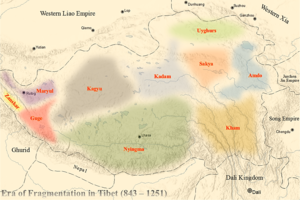Kingdom of Maryul
Maryul (Ladakhi: མར་ཡུལ།), also called mar-yul of mnga'-ris,[1][2] was the western-most Tibetan kingdom based in modern-day Ladakh and some parts of Tibet.For instance, the Chinese Buddhist pilgrim Xuanzang referred to it as Mo-lo-so, which would lead to a reconstructed name such as *Malasa, *Marāsa, or *Mrāsa.A. H. Francke believed that the second heir Tashigon received "a long and narrow strip of country along the northern slope of the Himalayas, of which Purang and Guge are the best-known provinces".[18] He also favoured Zahidurddin Ahmad's revised translation of the text from Ladakh Chronicles, which states that all the places mentioned in the description lie on the frontier of Maryul, including Demchok Karpo and Raba Marpo.[35] During his reign, Blo-gros-mc-og-Idan sent presents to the 1st Dalai Lama, patronized the Gelug scholar gSan-p'u-ba Lha dban-blo-gros, and raided the Kingdom of Guge.[38] According to the Ladakh Chronicles, the warlike Lhachen Bhagan formed an alliance with the people of Leh and dethroned the Maryul king Blo-gros-mc-og-ldan and his brothers drun-pa A-li and Slab-bstan-dar-rgyas.[39] Sengge Namgyal (r. 1616–1642), the "Lion" King, made efforts to restore Ladakh to its old glory by an ambitious and energetic building program including the Leh Palace and the rebuilding of several gompas, the most famous of which are Hemis and Hanle.At the end of the conflict, in 1684, the Treaty of Tingmosgang was agreed, affirming that: The boundaries fixed, in the beginning, when king Skyed-lda-ngeema-gon [Nyimagon] gave a kingdom to each of his three sons shall still be maintained.Ladakh was instructed in the treaty:[45] to keep watch at the frontier of Buddhist and non-Buddhist peoples, and out of regard for the doctrine of Buddha ... not allow any army from India to proceed to an attack [upon Tibet].


GHAZNAVIDEMPIREGURJARA-PRATIHARASPALA EMPIREHINDUSHAHISMARYULLOHA-RASWESTERN CHALUKYAKARA-KHANIDSLhachen PalgyigonEra of FragmentationJammu and Kashmir (princely state)PakistanLadakhiTibetanLadakhKyide NyimagonZoji LaKashmirDemchokNamgyal dynastyZorawar SinghJammu and KashmirXuanzangZan-zunHudud al-AlamMirza Haidar DughlatJesuit missionaryLuciano PetechPersianLangdarmaPurangMayum LaGuge and PurangZanskarA. H. FranckeFranckeThok JalungDemchok KarpoSpanggurRupshuSuru RiverKargilLahul and SpitiBaltistanShey PalaceAlchi MonasteryYeshe-ÖLhachen Utpala1st Dalai LamaNamgyal dynasty of LadakhLeh PalaceSengge NamgyalLhachen BhagangompasMughal EmpireTibet–Ladakh–Mughal WarTreaty of TingmosgangLha-ri streamDogra–Tibetan WarDogra dynastyTreaty of ChushulHistory of LadakhWylie transliterationVajrayanaChakrasamvaraKailasMahesvaraSumeruHenry StracheySpanggur TsoRutog CountySengge Zangbo CountyGartokFrancke, August HermannAsian Educational ServicesPetech, Luciano